Curated From www.animenewsnetwork.com Check Them Out For More Content.
Final Fantasy VII Rebirth initially launched on the last day of February, and if you look at the date of this review’s publication, you will immediately be able to discern one thing about this second entry of the FF7 Remake series: It is gargantuan. The first game got plenty of praise (and plenty of flak) for taking the relatively short first act of the original Final Fantasy VII and transforming it into a blockbuster experience in its own right that lasted a couple dozen hours, easy. That is nothing compared to the ambition of Final Fantasy VII Rebirth. Encompassing the vast majority of the original game’s middle acts, Rebirth is nothing short of miraculous in the ways that it expands and fleshes out the world of FF7 in a way that makes it feel like a real, living place for the first time. Just finishing the main story alone will likely take you almost twice as long as in Remake, so long as you’re not blowing past literally every side-quest and optional battle that the various open-world sections of the game have to offer. If I tried to go back and see everything that this game has to offer, my playtime hours would easily balloon into the triple-digits. Back in 1997, we had to use imagination to fill in the blanks and color in the abstractions of Cloud and Co.’s journey across the hills and valleys of their world. Now, every step of their adventure has been realized in mind-bogglingly expensive detail. If nothing else, Rebirth stands tall as the grandest Final Fantasy title in terms of scale and scope.
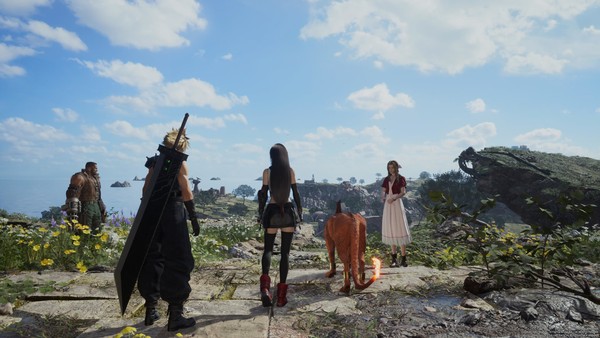
©SQUARE ENIX
For my money, it beats out its brethren in almost every other respect. While it is still too early to tell if this Remake project will cement itself as my personal favorite Final Fantasy, I have spent enough time with the game to know that I’ve never been quite so impressed with an entry in this series. The amount of “Holy Crap!” wonder that I experienced so often while playing through Rebirth was enough to make me feel like I was a kid again, getting my mind blown by discovering one of the all-time great RPGs for the first time.
This is because, as was the case in Remake, this game captures the spirit of Final Fantasy VII so perfectly. This is partially thanks to how the returning party members from Remake get even more opportunities to build bonds and demonstrate their chemistry. They were already beloved beyond belief before this project started, and the amount of care and detail that has gone into fleshing out this cast of misfit heroes is nothing short of astonishing. By the time Rebirth concluded, the FF7 crew had cemented themselves as one of the best-realized casts in all of gaming, period. Tifa and Aerith’s camaraderie, in particular, has become one of the emotional lynchpins of this entire series, and pretty much any scene that focuses on their friendship is guaranteed to be a highlight. Barret’s arc from the original game hits a lot harder in this updated version, thanks to the wonders of Square Enix‘s kajillion-dollar budget, and Red XIII makes himself an indispensable part of the party after playing a guest starring role in Remake (Red’s voice actor, Max Mittleman, gets some of the most charming and hilarious line deliveries in the whole game).
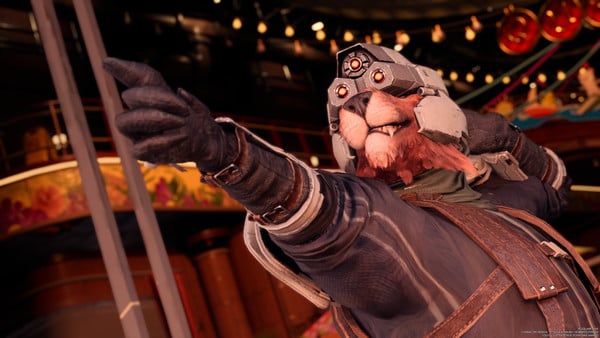
©SQUARE ENIX
What’s even more impressive is how the game handles all the new things it offers. For one, both Yuffie and Cait Sith have been added not only as core members to the party available for battle, but their presence in the story is so much more felt than in the original. They still function primarily as comedy-relief supporting players for Cloud, Aerith, Tifa, and Barrett’s story arcs, but that is perfectly fine, and they still manage to hold their own in the characterization department thanks to how much time the game devotes to expanding their roles in this game’s version of events. Yuffie doesn’t just hang around in the background until her side-quest in Wutai becomes relevant; she is a key player in many significant story beats, and her irrepressibly positive attitude is a welcome breath of fresh air when the core cast goes through more harrowing and life-altering ordeals as the story progresses. The same goes for Cait Sith, who has gone from a barely present walking plot device to a whole person! Well, a whole cat-robot-on-top-of-a-moogle-robot…thing. You get the idea.
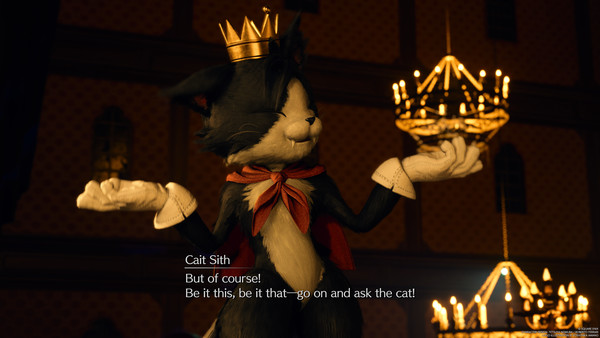
©SQUARE ENIX
I could go on and on about how much I love everything about what this redux of FF7’s main plot has to offer, which I know might end up being a contentious opinion. Much ballyhoo was made about the “diversions” that Remake began indulging in when it reached its climax and without spoiling anything, I can tell you that Rebirth goes even crazier with the time/memory/reality-altering shenanigans, especially when we begin barreling towards the story’s climax, which features a remix of one of gaming’s most infamous cutscenes ever. I won’t pretend that I fully understand the implications of how Rebirth handles this universe’s increasingly tangled knot of lore expansion and timeline revision. Still, I’ve never minded when Final Fantasy goes for broke and gets straight-up bonkers with its storytelling. All I can say is that if you hated what Remake started to do in its final hours, you likely would have no patience for what it gets up to in Rebirth. Conversely, suppose you’re like me and are willing to entertain a somewhat ludicrous mystery for at least one more chapter. In that case, I cannot imagine that a little bit of convoluted writing will be enough to drag down the otherwise stellar storytelling on display throughout Rebirth’s very long campaign.
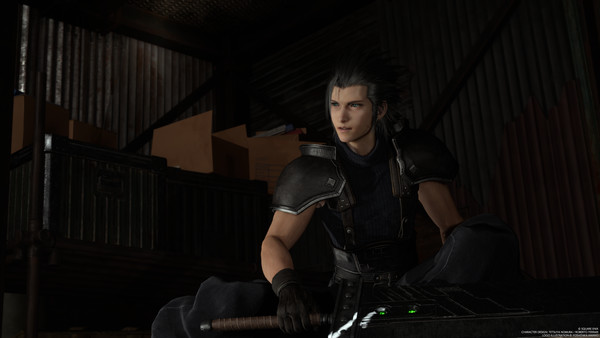
©SQUARE ENIX
Speaking of which, I know that another point of contention is just how completely chock-full of absurd amounts of content this game is. Especially now, in 2024, I can empathize with how easy it is to get tired of how many modern blockbusters, especially the ones that debut on the PlayStation 5, insist on fitting into the formula of the bloated open-world action-adventure game. I won’t lie to you, either: Sometimes, Final Fantasy VII Rebirth can feel like way too much all at once. Just look at the fact that it took me months to review the gosh-darned thing. Every open-world zone has dozens of monster bounties, tower climbs, summon-material synchronizations, and bespoke mini-game-focused quest arcs to complete. All of that is on top of the story-related side quests, the Queen’s Blood card battles, Chadley’s endless stream of VR missions, the repairable Chocobo Stops, and the free-time obliterating distraction that is the Golden Saucer. For better and for worse, directors Naoki Hamaguchi, Motomu Toriyama, and Tetsuya Nomura were paying attention to the criticism leveled at Final Fantasy XV‘s relatively sparse and unengaging map. You will never, ever want for things to do in this game.
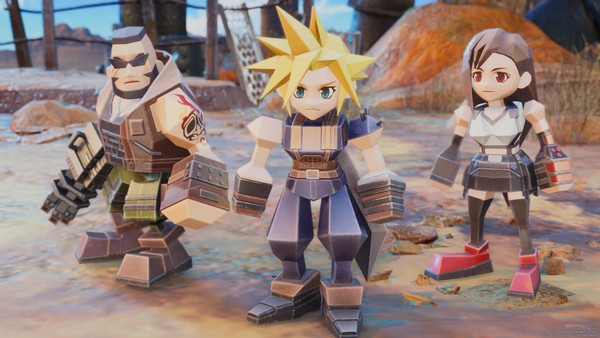
©SQUARE ENIX
Here’s the thing, though: For as cynical as I can get about overstuffed open-worlds and excessively self-indulgent AAA bloat…Final Fantasy VII Rebirth caught me in its trap, hook, line, and sinker. I loved how its various side activities reward the player with meaningful loot and materia while also providing a lot of fascinating background information about the different environments and cultures of the world. The writing for the small side-quest stories is, at least in my opinion, better than they were in Remake, too. Sure, navigating the more complex and labyrinthine maps of Gongaga and Cosmo Canyon was occasionally a little maddening, but the friction and engagement go a long way towards making the gang’s hunt for Sephiroth into something that truly encompasses an entire world. Plus, the presentation of all of this content is off-the-charts good.
The game’s excellent graphics push the PS5’s hardware to its limits, so much so that I still preferred playing in the more stable “Quality” mode at 30fps for the entirety of my playtime, even after the game received several patches to improve the “Performance” mode’s stability. Everything is so damned lush and detailed that I was happy to explore every nook and cranny of every zone and to beat up every mini-boss I encountered along the way.
It doesn’t hurt that the game sounds just as pleasing as it looks, what with an OST that features a genuinely deranged amount of great music. Seriously, the original draft of this review had two extra paragraphs about how great the new tracks and the returning favorites are. Still, this review is already overlong and overdue, and I’m doing my best to spare my editors any more stress. So, allow me to save some space and simply tell you that the music in Final Fantasy VII Rebirth owns. The same goes for Queen’s Blood. It has overtaken Triple Triad as my favorite FF minigame ever. I hope Square Enix gives us some more opportunities to engage in exciting duels over a children’s card game with some DLC down the line.
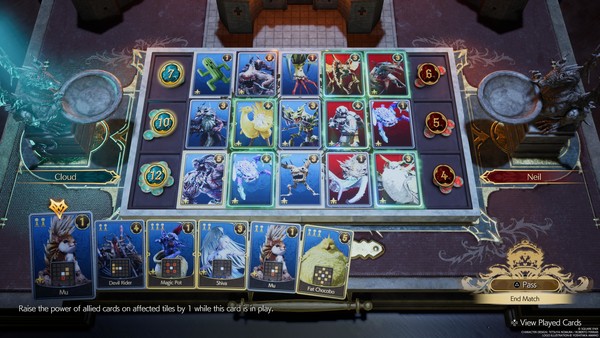
©SQUARE ENIX
Now, I know that I have been rather effusive with my praise for the past 1500 words or so, but it is my duty as both a critic and a longtime Final Fantasy fan to report that Rebirth is, technically, not a perfect video game. I’ve already mentioned the inconsistent and blurry visuals you get when trying to run the game at 60fps, which is a bummer. A game with literally dozens of minigames and diversions is bound to have a few clunkers (do feel free to patch out that infernal goddamned frog-jumping minigame in Junon whenever you like, Square. Please and thank you).
Those are all minor nitpicks, though, and they don’t affect my opinion of the game meaningfully. More significant, though, is that one of the game’s most important and prevalent features — its combat and the RPG mechanics involved therein — is ever so slightly downgraded compared to Final Fantasy VII Remake. To be clear, that means that the game’s combat is still, by and large, quite excellent, but it falls short of the near perfection that I felt Remake achieved with its hybrid real-time/ATB system. This isn’t due to any major changes to the gameplay itself, as Rebirth largely plays identically to Remake when you’re actually in a battle. Each character has a unique set of weapon-based skills that you can activate on the fly or by slowing down the fight and digging into the menus. Those abilities are complemented by the many varieties of offensive and supportive Materia you equip to characters and level up to access powerful magic spells. So far, so good.
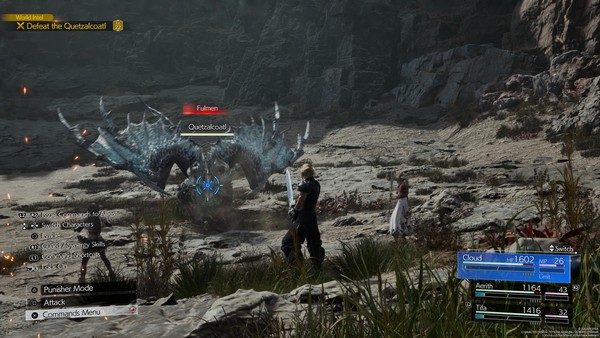
©SQUARE ENIX
The problems arise more in the overall structure of your party and in the way the game has changed characters’ leveling and development. In Remake, the game struck an awesome balance with its four playable characters: Cloud, Tifa, Barrett, and Aerith, who played well with each other in practically any combination and switching between them throughout battle was fun and satisfying. In adding Red XIII, Yuffie, and Cait Sith to the mix, Rebirth often struggles to capitalize on that exquisite mechanical balance in the same way. The three new party members are great fun to use, but having over a dozen different party permutations to choose between would always be challenging to balance, no matter how often the game tries to force you to switch things up with some mandatory party swaps. I honestly have no clue how the final game in the series will be able to handle things once Cid and Vincent fully join the party as well.
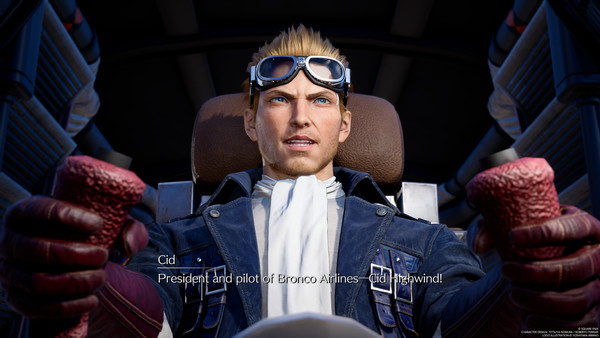
©SQUARE ENIX
This party bloat is compounded with the new Character Folio Trees, which completely usurps the now automated Weapon Development system from Remake. In short, each character now has a personalized skill tree that expands as you complete side-quests and use the new Synergy Skills that allow specific pairs of characters to team up in battles. The Synergy moves are cool, but I do not like the Folio Trees. They feel abstract and fiddly in ways that the Weapon Trees in Remake never did, and I didn’t have much fun pouring Skill Points into them, even when they unlocked new Synergy Skills or passive buffs. The Folios offer some diversity of choice in character builds that might be fun if you played the game again on Hard Mode after beating it, but I never appreciated the extra work they demanded on top of managing Materia and crafting the loads of new equipment on offer. The game might have felt smoother and more streamlined if the Folios were left out altogether.
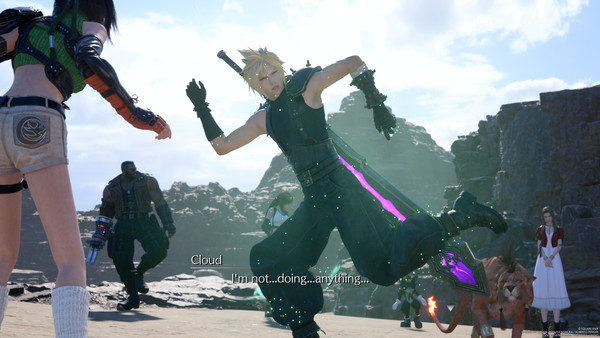
©SQUARE ENIX
Are some janky new systems and a handful of lame minigames enough to keep this game from achieving its grand ambitions? I don’t think so at all. While the jury is still out on whether the story’s weirder and wilder goals will sit well with fans when all is said and done, I think Square Enix has gone a long way towards cementing this version of Final Fantasy VII as being every bit as wonderful and impactful as its progenitor. I’ve been in love with Final Fantasy for the better part of twenty-five years now, so believe me when I say that when it comes to the amount of raw, joyous spectacle that this game manages to squeeze out of a story that I’ve had memorized since I was in the fourth grade, Final Fantasy VII Rebirth is nothing short of a miraculous. I cannot imagine how Square Enix could top themselves after this, but I will be dying of anticipation for the next few years while we wait to find out.

